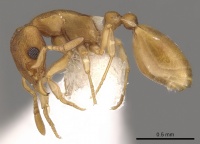Colobostruma lacuna
| Colobostruma lacuna | |
|---|---|

| |
| Scientific classification | |
| Kingdom: | Animalia |
| Phylum: | Arthropoda |
| Class: | Insecta |
| Order: | Hymenoptera |
| Family: | Formicidae |
| Subfamily: | Myrmicinae |
| Tribe: | Attini |
| Genus: | Colobostruma |
| Species: | C. lacuna |
| Binomial name | |
| Colobostruma lacuna Shattuck, 2000 | |
Colobostruma lacuna has been found in dry, open forested areas where it nests in soil.
Identification
This species can be separated from close relatives by the combination of 5 or more antennal segments, the shallow V-shaped posterior margin of the head and the anterior region of the head being set off from the posterior regions by a rounded angle and thus being weakly phragmotic . This last character is intermediate between the rounded, non-phragmotic condition found in most species and the highly phragmotic Colobostruma leae. The anterior region of the head is relatively flat or weakly convex and is set above the posterior and posterolateral regions of the head which are concave dorsally and round abruptly into the lateral regions (Shattuck 2000). .
Keys including this Species
Distribution
Limited to north-eastern New South Wales and south-eastern Queensland.
Latitudinal Distribution Pattern
Latitudinal Range: -21.96667° to -29.75°.
| North Temperate |
North Subtropical |
Tropical | South Subtropical |
South Temperate |
- Source: AntMaps
Distribution based on Regional Taxon Lists
Australasian Region: Australia (type locality).
Distribution based on AntMaps
Distribution based on AntWeb specimens
Check data from AntWeb
Countries Occupied
| Number of countries occupied by this species based on AntWiki Regional Taxon Lists. In general, fewer countries occupied indicates a narrower range, while more countries indicates a more widespread species. |

|
Estimated Abundance
| Relative abundance based on number of AntMaps records per species (this species within the purple bar). Fewer records (to the left) indicates a less abundant/encountered species while more records (to the right) indicates more abundant/encountered species. |

|
Biology
Castes
Nomenclature
The following information is derived from Barry Bolton's Online Catalogue of the Ants of the World.
- lacuna. Colobostruma lacuna Shattuck, in Bolton, 2000: 36 (w.q.) AUSTRALIA (New South Wales, Queensland).
- Type-material: holotype worker, 30 paratype workers, 1 paratype queen.
- Type-locality: holotype Australia: New South Wales, Bom Bom State Forest, 5 mi. S Grafton, 150 ft, 25.viii.1967, dry sclerophyll, Eucalyptus maculata forest, no undergrowth, little or no grass, in clay soil close to Bothroponera mayri nest (B.B. Lowery); paratypes with same data.
- Type-depositories: ANIC (holotype); ANIC, BMNH, MCZC (paratypes).
- Distribution: Australia.
Type Material
- Holotype, worker, Bom Bom State Forest, 5mi. S Grafton, New South Wales, 150 ft, Australia, 25 August 1967, B.B. Lowery, Australian National Insect Collection; dry sclerophyll, Eucalyptus maculata forest with no undergrowth, little or no grass, in clay soil close to Pseudoneoponera mayri nest.
- Paratype, 30 workers, 1 queen, Bom Bom State Forest, 5mi. S Grafton, New South Wales, 150 ft, Australia, 25 August 1967, B.B. Lowery, Australian National Insect Collection, The Natural History Museum, Museum of Comparative Zoology; dry sclerophyll, Eucalyptus maculata forest with no undergrowth, little or no grass, in clay soil close to Pseudoneoponera mayri nest.
Unless otherwise noted the text for the remainder of this section is reported from the publication that includes the original description.
Description
Worker
HOLOTYPE. TL 3. 3, HL 0.75 , HW 0.77, CI 102, ML 0.21, MI 28, SL 0.35, SI 45, PW 0.56, AL 0.87. Anterior region of head raised above the posterior regions and separated from it by a rounded angle, thus the head weakly but not obviously phragmotic. In full-face view ridge immediately in front of eye flat to weakly concave posteriorly, concave anteriorly. Frontal lobes and lateral margins of clypeus smooth relative to the surrounding surface of the head. Mandibles broadly triangular. Hairs absent from dorsum of head. Posterior margin of head forming a shallow V-shape, with relatively flat sides which meet medially in an angle. Antenna with 6 segments, often with the third and fourth funicular segments, counting from the base, partially or completely subdivided into additional segments. Scape strongly elbowed and without a subbasal lobe. In dorsal view the widest point of the pronotum is at the humeral angles. Propodeum high, its posterior face approximately the height of the petiolar node and with broad, thin lamellae; in profile the dorsum of the alitrunk broadly and weakly convex. Lateral postpetiole drawn outwards into thin flange-like wings, the wings with translucent windows along both their anterior and posterior margins, the windows separated by a narrow band of thickened integument and the anterior windows smaller than the posterior windows. First gastral tergite with very fine, delicate, closely spaced punctations, its anterior one-quarter with low, closely spaced carinae. Body colour yellow, dorsum of head slightly darker, antennae and legs slightly lighter, first gastral tergite often with slightly infuscated, weakly defined spots medially and laterally.
References
- Shattuck, S. O. 2000. Genus Colobostruma. Genus Mesostruma. Genus Epopostruma. Pp. 31-67 in: Bolton, B. The ant tribe Dacetini. Mem. Am. Entomol. Inst. 65: 1-1028 (page 36, worker, queen described)
References based on Global Ant Biodiversity Informatics
- Bolton, B. 2000. The Ant Tribe Dacetini. Memoirs of the American Entomological Institute 65


